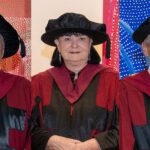C231/08
20 August 2008
The Curtin University of Technology science community experienced a synchrotron experiment in real time, in a first for students and staff who have never before seen its high impact capability.
Curtin beamed a live experiment from the football field sized synchrotron in Melbourne in what will be the first of a number of experiments to be teleconferenced to students in Perth.
Thirty five Curtin chemistry, physics and nanotechnology students studying x-ray diffraction and physical chemistry, together with chemistry and physics students from Monash University, watched the experiment unfold in Melbourne, where Curtin’s Professor Roland de Marco staged the research.
The synchrotron is a $207 million facility which works by accelerating electrons to almost the speed of light and as the electrons are deflected through magnetic fields they create extremely bright light. The light is channelled down beamlines to experimental workstations where it is used for research.
The synchrotron generated light is unique in its brilliance and narrow focus and can be generated across the range of the electromagnetic spectrum: from infrared to x-rays. In this instance, the light is captured and customised for use in an experiment that measures the corrosive effect of seawater on steel during a five hour period, as it pertains to an oil and gas pipeline.
Professor Roland de Marco, Dean of Research, Science and Engineering at Curtin is a world expert in synchrotron science and electrochemistry and designed the experiment.
“We examined x-ray diffraction of the corrosion process of a mild steel electrode. By measuring the surface diffraction patterns in real-time, as well as simultaneously recording its corrosion chemistry using standard electrochemical techniques, we have been able to determine the surface chemistry relating to various stages of corrosion.” Professor de Marco said.
A novel cell was designed and constructed by Professor de Marco for the purpose of this experiment. Its purpose is to provide the correct physical configuration, allowing electrochemical and synchrotron diffraction experiments on the corrosion process in real-time whilst the samples sits in the synchrotron x-ray beam.
“The cell provides an electrochemical interface, and is specifically designed to be attached inside the synchrotron and provide an ideal medium for identification of reaction products on electrode surfaces, during controlled electrochemical oxidation/corrosion of the metal under conditions representative of an oil pipeline in an marine environment,” Professor de Marco said.
Professor Roland de Marco outlined the advantages of Curtin’s Australian Synchrotron foundation membership, held in conjunction with the Department of Industry and Resources (DOIR) and The University of WA (UWA) and offering significant beam time.
“Curtin has utilised hundreds of hours access across the four operational beamlines during the past year, which is part of their contractual agreement as one of the founding members,” Professor de Marco said.
“Our undergraduate and postgraduate students, as well as staff, are able to take full advantage of the high brightness of the synchrotron to undertake unique experiments such as the high resolution imaging of bones and tissues, the analysis of forensic evidence such as hair on poisoned victims, monitoring of the maturation of human eggs in in vitro fertilisation (IVF) and measuring corrosion in situ over a specified period of time.
The brightness of the beam is the key factor that enables success with these otherwise difficult and challenging experiments.”
The Melbourne facility is the second synchrotron to be located in the southern hemisphere and one of only 40 synchrotrons which are located worldwide.
Contact: Roland de Marco, Dean of Research, Science and Engineering, Curtin 08 9266 7322, r.demarco@curtin.edu.au or Lisa Mayer, PR Coordinator, Curtin, 08 9266 1930, 0401 103 755 l.mayer@curtin.edu.au
CRICOS provider code: 00301J
Modified: 20 August 2008


